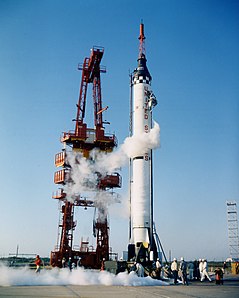
Back Startovací komplex 5 na Cape Canaveral Air Force Station Czech Launch Complex 5 German Συγκρότημα εκτοξεύσεων 5 Greek Cape Canaveral AFS LC-5 Finnish Complexe de lancement 5 French केप केनवरल एयर फोर्स स्टेशन अंतरिक्ष प्रक्षेपण परिसर 5 Hindi Kompleks Peluncuran 5 Cape Canaveral ID Launch Complex 5 Italian ケープカナベラル空軍基地第5発射施設 Japanese Cape Canaveral Air Force Station Lanceercomplex 5 Dutch
 Mercury-Redstone 1 at LC-5 in 1960 | |||||||||||||
 | |||||||||||||
| Launch site | Cape Canaveral Space Force Station | ||||||||||||
|---|---|---|---|---|---|---|---|---|---|---|---|---|---|
| Location | 28°26′22″N 80°34′24″W / 28.43944°N 80.57333°W | ||||||||||||
| Short name | LC-5 | ||||||||||||
| Operator | U.S. Space Force | ||||||||||||
| |||||||||||||
Cape Canaveral Launch Complex 5 (LC-5) was a launch site at Cape Canaveral Space Force Station, Florida used for various Redstone and Jupiter launches.
It is most well known as the launch site for NASA's 1961 suborbital Mercury-Redstone 3 flight, which made Alan Shepard the first American in space. It was also the launch site of Gus Grissom's July, 1961, Mercury-Redstone 4 flight. The Mercury-Redstone 1 pad abort, Mercury-Redstone 1A, and the January, 1961, Mercury-Redstone 2 with a chimpanzee, Ham, aboard, also used LC-5.
A total of 23 launches were conducted from LC-5: one Jupiter-A, six Jupiter IRBMs, one Jupiter-C, four Juno Is, four Juno IIs and seven Redstones. The first launch from the complex was a Jupiter-A on July 19, 1956 and the final launch was Gus Grissom's Liberty Bell 7 capsule on July 21, 1961.[1]
LC-5 is located next to the Cape Canaveral Space Force Museum which is located at LC-26. The original launch consoles and computers are on display in the LC-5 blockhouse. As of 2020[update], a tour of the museum can be arranged through the Kennedy Space Center Visitor Complex's "Cape Canaveral: Early Space Tour". One tour is offered daily, so the number of visitors is limited by the size of the tour.
- ^ "Archived copy". Archived from the original on 2009-04-14. Retrieved 2009-04-14.
{{cite web}}: CS1 maint: archived copy as title (link)
© MMXXIII Rich X Search. We shall prevail. All rights reserved. Rich X Search